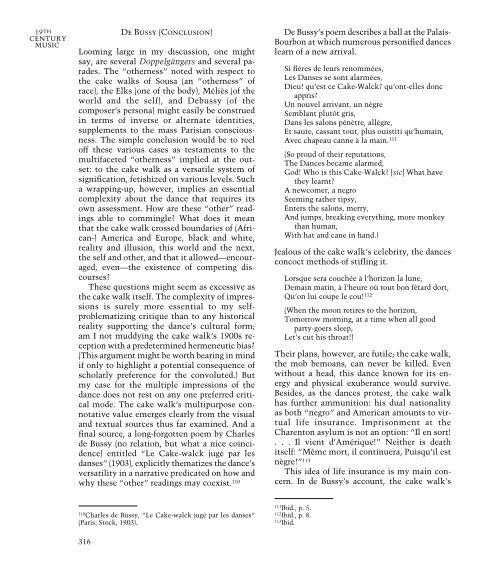Parisian Cake Walks.pdf - ResearchSpace@Auckland
Parisian Cake Walks.pdf - ResearchSpace@Auckland
Parisian Cake Walks.pdf - ResearchSpace@Auckland
You also want an ePaper? Increase the reach of your titles
YUMPU automatically turns print PDFs into web optimized ePapers that Google loves.
19TH<br />
CENTURY<br />
MUSIC<br />
316<br />
De Bussy (Conclusion)<br />
Looming large in my discussion, one might<br />
say, are several Doppelgängers and several parades.<br />
The “otherness” noted with respect to<br />
the cake walks of Sousa (an “otherness” of<br />
race), the Elks (one of the body), Méliès (of the<br />
world and the self), and Debussy (of the<br />
composer’s persona) might easily be construed<br />
in terms of inverse or alternate identities,<br />
supplements to the mass <strong>Parisian</strong> consciousness.<br />
The simple conclusion would be to reel<br />
off these various cases as testaments to the<br />
multifaceted “otherness” implied at the outset:<br />
to the cake walk as a versatile system of<br />
signification, fetishized on various levels. Such<br />
a wrapping-up, however, implies an essential<br />
complexity about the dance that requires its<br />
own assessment. How are these “other” readings<br />
able to commingle? What does it mean<br />
that the cake walk crossed boundaries of (African-)<br />
America and Europe, black and white,<br />
reality and illusion, this world and the next,<br />
the self and other, and that it allowed—encouraged,<br />
even—the existence of competing discourses?<br />
These questions might seem as excessive as<br />
the cake walk itself. The complexity of impressions<br />
is surely more essential to my selfproblematizing<br />
critique than to any historical<br />
reality supporting the dance’s cultural form;<br />
am I not muddying the cake walk’s 1900s reception<br />
with a predetermined hermeneutic bias?<br />
(This argument might be worth bearing in mind<br />
if only to highlight a potential consequence of<br />
scholarly preference for the convoluted.) But<br />
my case for the multiple impressions of the<br />
dance does not rest on any one preferred critical<br />
mode. The cake walk’s multipurpose connotative<br />
value emerges clearly from the visual<br />
and textual sources thus far examined. And a<br />
final source, a long-forgotten poem by Charles<br />
de Bussy (no relation, but what a nice coincidence)<br />
entitled “Le <strong>Cake</strong>-walck jugé par les<br />
danses” (1903), explicitly thematizes the dance’s<br />
versatility in a narrative predicated on how and<br />
why these “other” readings may coexist. 110<br />
110 Charles de Bussy, “Le <strong>Cake</strong>-walck jugé par les danses”<br />
(Paris: Stock, 1903).<br />
De Bussy’s poem describes a ball at the Palais-<br />
Bourbon at which numerous personified dances<br />
learn of a new arrival.<br />
Si fières de leurs renommées,<br />
Les Danses se sont alarmées,<br />
Dieu! qu’est ce <strong>Cake</strong>-Walck? qu’ont-elles donc<br />
appris?<br />
Un nouvel arrivant, un nègre<br />
Semblant plutôt gris,<br />
Dans les salons pénètre, allègre,<br />
Et saute, cassant tout, plus ouistiti qu’humain,<br />
Avec chapeau canne à la main. 111<br />
(So proud of their reputations,<br />
The Dances became alarmed,<br />
God! Who is this <strong>Cake</strong>-Walck? [sic] What have<br />
they learnt?<br />
A newcomer, a negro<br />
Seeming rather tipsy,<br />
Enters the salons, merry,<br />
And jumps, breaking everything, more monkey<br />
than human,<br />
With hat and cane in hand.)<br />
Jealous of the cake walk’s celebrity, the dances<br />
concoct methods of stifling it.<br />
Lorsque sera couchée à l’horizon la lune,<br />
Demain matin, à l’heure où tout bon fêtard dort,<br />
Qu’on lui coupe le cou! 112<br />
(When the moon retires to the horizon,<br />
Tomorrow morning, at a time when all good<br />
party-goers sleep,<br />
Let’s cut his throat!)<br />
Their plans, however, are futile; the cake walk,<br />
the mob bemoans, can never be killed. Even<br />
without a head, this dance known for its energy<br />
and physical exuberance would survive.<br />
Besides, as the dances protest, the cake walk<br />
has further ammunition: his dual nationality<br />
as both “negro” and American amounts to virtual<br />
life insurance. Imprisonment at the<br />
Charenton asylum is not an option: “Il en sort!<br />
. . . Il vient d’Amérique!” Neither is death<br />
itself: “Même mort, il continuera, Puisqu’il est<br />
nègre!” 113<br />
This idea of life insurance is my main concern.<br />
In de Bussy’s account, the cake walk’s<br />
111 Ibid., p. 5.<br />
112 Ibid., p. 8.<br />
113 Ibid.















